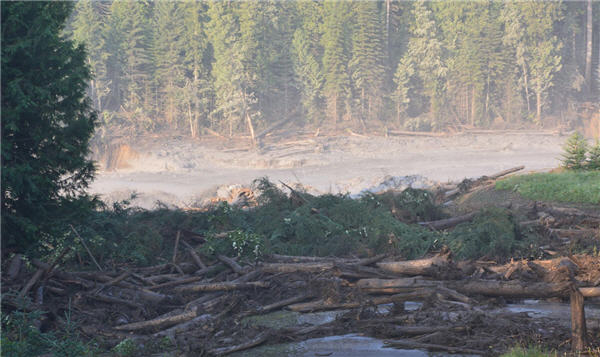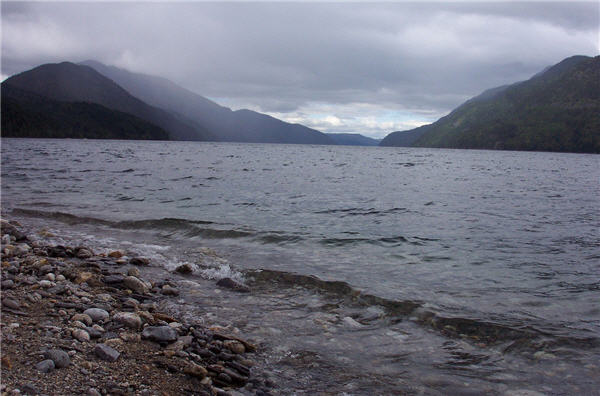
Debris washing down a creek after the Mount Polley tailings pond breach. Image from Cariboo Regional District Emergency Operations Centre.
It will take some to determine the long-term environmental effects of the Mount Polley Mine tailings pond breach, according to a UNBC researcher familiar with the area.
Dr. Philip Owens, an associate professor in the school’s environmental science program, was one of the local academics headed out to UNBC’s Quesnel River Research Centre in Likely on Tuesday.
“There’s a cascading effect of concerns here,” said Owens, who noted immediate questions regarding the amount of water, sediment and chemical introduced to Polley Lake, Hazeltine Creek and Quesnel Lake after the mine southeast of Quesnel suffered a rupture in its tailings pond dam Monday morning.
According to a statement by Energy and Mines Minister Bill Bennett, about 10 million cubic metres of water and 4.5 million cubic metres of sand were released, prompting the Cariboo Regional District to issue a precautionary ban on drinking or bathing in the water for the affected areas.

Hurricane Point, Quesnel Lake, the deepest lake in British Columbia. Image from Wikipedia.
Mine owner Imperial Metals has said the water is not acidic, which Owens said is one concern off the table.
“But again, it’s a lot of water and we don’t fully know what’s in it – obviously the mine knows exactly what’s in it, but I don’t at the moment,” he said. “I think we need to understand a little bit more about what’s in that water and sediment before we’re able to make some really strong statements about what the long-term impacts are going to be.”
The Quesnel River Research Centre already has background data on the area and has been collecting samples since the Monday breach.
“We have strong ties to these communities – the Quesnel River Research Centre is in Likely – so this is devastating to us, but we’re trying to do the best we can to try and understand what’s happening and how we can help remediate this problem,” Owens said.
Owens and fellow UNBC faculty member Ellen Petticrew were planning to get an aerial tour of the site on Thursday morning, but he said that from the images he’s already seen and colleagues he’s spoken to, the effects on the surrounding ecosystem were severe.
The waterways look nothing like they did before, Owens said.
So those creeks are going to be quite devastated and, particularly in terms of the fish and aquatic organisms, they’re going to be severely impacted,” he said. “Lots of trees have been blown out along the river system as well, which is being delivered to the lake.”
Removing those trees to prevent a log jam where the lake turns into the river would be an immediate problem to address, but there are other issues down the line, such as whether any metals associated with mining activities – such as arsenic – leak into the groundwater system.
>Long-term effects to the communities’ tourism and fishing industries are also up in the air.
“We’re just about to come into the return of the salmon and the Quesnel Lake is a very important salmon lake and some of the upstream rivers are critical for the stocks, like the Horsefly,” said Owens. “So that is a huge concern bearing in mind that this was due to be a peak year for the salmon flows in the local area and we don’t know what this is going to do to that stock of salmon.”
Mines set up tailings ponds, which is the finely ground rock left over once mineral concentrate is removed during the mining process. They are normally deposited in a water-based slurry into a specially built lagoon. Once stored, the rock and the water will separate, with the rock settling at the bottom, according to MiningFacts.org